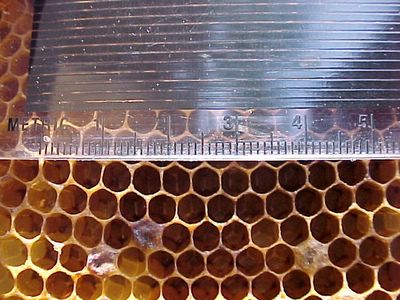Here is a photo of the frame adjoining the primary comb in the other picture. Out of curiosity, I gathered three center frames out of a hive that had housed a swarm from late fall of 2004. The hive had cold starved over winter, and these frames were clear of most brood, allowing me to get good measurements of the majority of empty comb. I started laying the ruler on the comb to measure whether or not the size of these cells were close to that of natural sized or small cell bees, of which the comb is suppose to measure 49 centimeters across 10 cells in order to average out the cells at 4.9mm each. As I have done this often, I line up the left edge of the scale on the outside of a cell wall and look at the mark at 49 centimeters to see how close this mark comes to the nearest cell wall. The cell wall just happened to fall right on the mark, so I just chalked it up to another small cell colony, and didn't think too much about it. It wasn't until I had sent this pic off to another beekeeper and got his response, that it was brought to my attention there were actually 11 cells that fit in that span of 49 centimeters. As you see these cells average 4.4mm, which is smaller than the acclaimed size of 4.9mm for natural size bees. I immediately inserted these frames into the core of a nuc, to utilise this very small comb. I took measurements of the rest of the comb and the cells were fairly uniform as you can see in the surrounding cells in the photo, all of which were between 4.4 and 4.9mm, the frame on the other side of the primary comb measured between 4.6 and 5.1mm.
Some beekeepers say cells of this size are only drawn in the spring to early summer. The evidence says otherwise.
Too bad we had such a cold winter here in Michigan, and these girls got locked down and couldn't move over another frame or so to get the honey they needed to keep warm.


No comments:
Post a Comment